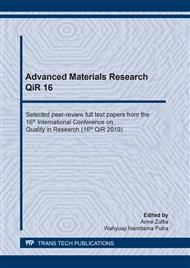p.220
p.227
p.233
p.238
p.248
p.257
p.265
p.272
p.278
The Comparison of Nitrogen Atom Solubility in the Formation of Surface Layer on Stainless Steel and Alloy Steel
Abstract:
The chrome alloy has better affinity with nitrogen atom in nitriding process than any other alloy elements in steel. The higher content of chrome element binds larger number of nitrogen atoms. However, the higher concentration of nitrogen atom on the surface of the steel does not often make thicker case depth. This study clarified the phenomenon. The nitriding process was performed in two stages, namely the boost stage in the fluidized bed with the composition of 80 % NH3 and 20 % of N2 in 4 hours at 550 °C. Subsequently, the diffusion process was carried out in fluidized bed with the gas composition of 100 % N2 HP (high purity) in 2 hours. The chemical composition was measured by spectrometry and EDAX. The case depth was identified by micro-Vickers, and metallography was observed by SEM. The concentration of nitrogen atom on the surface of AISI 316 L is twice higher than that on the AISI 4140. The result shows that 0.1 to 1 wt % of nitrogen atom creates diffusion layer, 1 to 5 wt % of nitrogen atom produces nitride layer of γꞌ and ε, and nitrogen atom above 5 wt % forms white layer. The layer strongly depends on the percentage of nitrogen atom concentration. The nitrogen atom concentration is determined by the concentration of chromium element within the steel (AISI 316 L). Meanwhile, the depth of nitrogen atom diffusion is highly determined by the alloy element of Fe (AISI 4140).
Info:
Periodical:
Pages:
248-254
Citation:
Online since:
July 2020
Authors:
Keywords:
Price:
Сopyright:
© 2020 Trans Tech Publications Ltd. All Rights Reserved
Share:
Citation:


